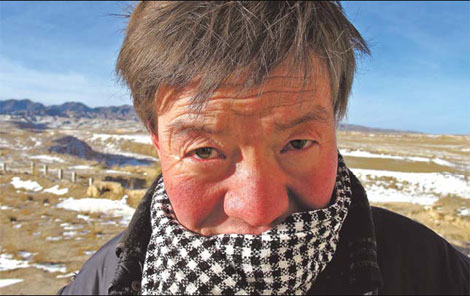Mysteries written in blood
Even in the harvest season, Liqian resembles a ghost town. Most residents have moved to Yongchang town, 20 km from the hamlet, or to Jinchang city, where the discovery of rich nickel deposits has led to a proliferation of energy plants.
 |
|
Sun Jianjun has done countless interviews about his European appearance. [China Daily] |
Despite being a shy man of few words, 33-year-old Sun Jianjun has accepted countless interviews about his European appearance. But, like everyone else, the man with naturally brown hair and blue eyes has to face the reality of the bottom line - that is, feeding his family and providing them with a better life.
Sun moved his family into a rented apartment in town six years ago. He does odd jobs, usually earning about 70 yuan ($11) a day.
"I am busy working now. I don't have time for interviews," Sun says with a thick local accent. He only accepts interviews arranged by the local government's cultural and publicity departments.
Luo Ying, another famous "Roman descendant" from Liqian, who has deep-set eyes and a hooked nose, is now working on the construction site of the new airport in Jinchang city.
Luo went to Beijing in 2006 for a DNA test arranged by the Institute of Archeology under the Chinese Academy of Social Sciences. It was discovered he is genetically 46 percent Caucasian. Luo politely refused an interview with China Daily. He isn't allowed to leave the construction site during work hours and doesn't want to lose his job, he says.
But not everyone agrees with the legion theory, and so the academic debate rages on.
Retiree Chen Zhengyi is one of China's most zealous advocates of Dubs' theory.
"How did a village suddenly appear on Han Dynasty territory that was recorded as a war prisoner settlement? Why was the village named 'Liqian', which sounds like 'legion'?" he says. "It can't be simply explained as a coincidence."
Chen has published academic papers and books to support his theory.
But Beijing Normal University professor Yang Gongle points out interracial marriages were common on the ancient Silk Road. "The villagers' European traits aren't enough to prove they are the Roman legion's descendants."
Lanzhou University scholar Liu Guanghua points out the "fish-scale" formation was used earlier in China.
Liu is also skeptical, because the region has long been inhabited by various ethnic groups and is connected to Central Asia.
A 2007 DNA test administered to 93 villagers by Lanzhou University's School of Life Science found 77 percent of villagers were closely related to Chinese ethnicities, mostly Han.
But folk researcher Song Guorong, who has long collected portraits of Liqian villagers, believes the DNA test results don't disprove the theory.
"The Roman empire covered vast territories, and many soldiers in the legion were mercenaries," he says.
But Song also admitted the theory lacks archeological evidence, such as Roman coins or weapons. The only physical artifact discovered in the area is a human skeleton believed to belong to a Roman soldier because it is 1.8 meters tall.
Last November, Chinese and Italian anthropologists co-founded the Italian Studies Center at Lanzhou University. To continue the study and archeological excavations related to the lost Roman legion will be the institute's major role.
In 2010, the Beijing Zhejiang Chamber of Commerce invested in building a "Roman city" near Liqian, construction on which has begun. The investment project also includes the production of a TV series entitled The Lost Roman Legion and a film.
 0
0 







Go to Forum >>0 Comments